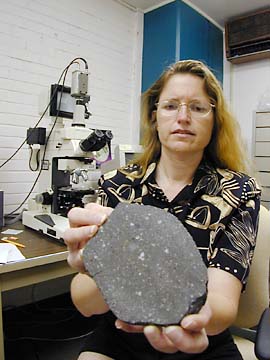


Scientist at
UH on the trail of
life’s origins
The organic geochemist's
By Helen Altonn
study of a meteorite rock zeroes
in on a pure carbon
Star-BulletinA Hawaii scientist and colleagues studying a 4.6-billion-year-old meteorite rock discovered it contains pure carbon molecules that may have had a role in the origin of life.
Luann Becker, University of Hawaii-Manoa organic geochemist, and fellow researchers detected large clusters of fullerene carbon molecules in the Allende meteorite that fell in Mexico in the late 1960s.
Their discovery is to be reported in tomorrow's issue of the British journal Nature.
"It raises questions about how solar nebula or the solar system formed and how carbon forms in stars," Becker said in a recent interview. "Where is it coming from?"
It's possible fullerenes are capturing extraterrestrial gases and delivering them to the surface of Earth and other planets, the Institute of Geophysics and Planetology scientist speculated.
If so, she said, "trapped gases could have played a role in how the Earth evolved -- maybe how life came about."
Becker is discussing the findings at a meeting of the International Society on the Origins of Life that began Sunday and ends tomorrow in San Diego.
She has been investigating fullerenes with Theodore E. Bunch and Louis J. Allamandola at NASA's Ames Research Center Space Science Division.
Fullerenes are large carbon molecules shaped like soccer balls. They also resemble the geodesic domes designed by American inventor Richard Buckminster Fuller. Thus, they're called buckminsterfullerenes or buckyballs.
American scientists Robert F. Curl Jr. and Richard E. Smalley and British researcher Harold Kroto won the 1996 Nobel Prize in chemistry for discovering fullerenes in 1985 as the third form of pure carbon. Diamonds and graphite are the others.
They accidentally synthesized the material in the laboratory while trying to learn how carbon clusters form in stars, Becker said. They predicted soccer-sized fullerenes in nature but never proved they existed, she said.
Becker and a colleague found extraterrestrial helium in fullerenes in the 1.85-billion-year-old Sudbury impact crater in Ontario, Canada, in 1998.
She then questioned: "Why don't we find an abundance of carbon in meteorites? They are nothing more than a collection of stardust and materials outside our solar system. If fullerenes are from stardust, why don't we find them in meteorites?"
She decided they weren't going about the search the right way, she said.
Working with a near-pristine rock from the Allende meteorite, which was observed falling, Becker's group developed an arduous process of extracting fullerenes.
They exploit a unique property characteristic of organic molecules, using acids to remove minerals, then an organic solvent to isolate fullerenes from the residue.
It was believed molecules with 60 or 70 carbon atoms were the only stable molecules that probably survived in space, Becker said. She and her associates not only found those, they discovered large quantities of molecules in the Allende meteorite with 100 and 400 atoms.
This was the first observation of higher fullerenes in nature.
Becker believes they're produced in an outflow of carbon from stars, noting, "Red giant stars appear to have stages where carbon formation is greater."
The carbon clusters form a three-dimensional closed structure that behaves like an organic molecule, Becker said. A hollow cage, it can trap gases, which potentially represent the beginning of the universe, she said.
"It demonstrates for the first time that this form of carbon is a ubiquitous form of carbon in the universe. It was predicted, but it takes a long time to prove."
The molecules are very strong and stable, able to survive the huge impact of a meteorite striking the Earth, she said.
"These objects are so big, with energetic impact so dramatic, scientists thought the material would be vaporized away.
"Now, we can see it's forming out there in the cosmos ... It's ubiquitous, coming to planets like Earth, and it's been there from the beginning. What was its role? I don't know, but it was there and it's pretty neat stuff.
"It has a lot of potential to tell us a lot about our universe," Becker added. "Any time we find a new form of carbon -- we live in a carbon-based world -- that's a pretty big deal."
Carbon and volatile materials, both essential for life, could be coming to Earth via fullerenes in extraterrestrial bodies, she said.
"We know organic molecules are of interest to people studying the origin of life," she pointed out. "Amino acids are the building block of life. This could be the signature, the marker we need, to look at the sedimentary record to see if amino acids or other material are surviving devastating effects."
Becker's next project is to investigate what's inside the extraterrestrial carbon molecules. "We might be able to discover their origin, if it's a giant red star or other environment in the cosmos."
She said she'd love to look at a lunar sample to see if fullerenes have been delivered to the moon. But it's difficult to ask for a lunar rock, since the methods she must use are destructive, she said.
Her research is supported by a grant from the NASA Cosmochemistry Program.
http://www.kaleo.org